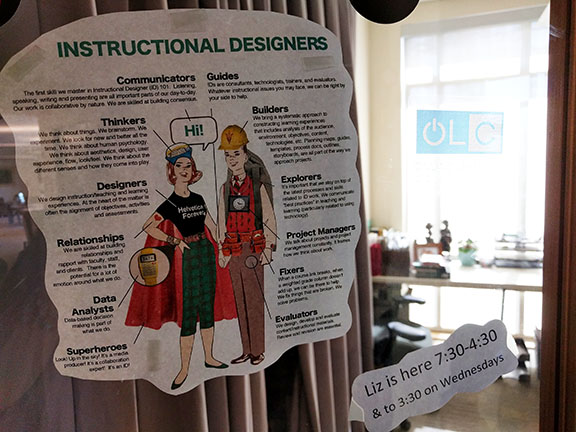
My office door with an illustration by Robert Kilman from the Arizona State University website TeachOnline
When I began my position as the Instructional Designer in Distance Education at Santa Rosa Junior College (SRJC) in the Fall of 2015, my new supervisor printed the illustration shown in the photo above and gave it to me. I taped it to my office door. Who wouldn’t like to be depicted as a fashionable superhero-explorer with a split personality? It’s also a pretty good representation of an action-packed job that marries creative thinking with technical problem-solving. Flexing different parts of my brain throughout the day keeps me excited about my work and on my toes.
Among the many roles I play, the one I reflect upon the most is Relationship Builder. The caption for the illustration states: “We are skilled at building relationships and rapport with faculty, staff, and clients. There is the potential for a lot of emotion around what we do.” The emotion was immediately evident to me at SRJC. My position was created at the same time that our college adopted Canvas to replace Moodle and a home-grown system called CATE. Emotions were loud and clear: many faculty felt overwhelmed by the transition, especially when it meant significantly reorganizing course materials to accommodate the Canvas interface.
Fortunately, many of those faculty attended our in-person Canvas workshops and appointments for help, and I was able to calm nerves by listening carefully to their concerns and providing support. I also encouraged faculty to share problems and solutions with each other. Building face-to-face relationships came easily to me and helped faculty make the transition.
Now that the transition to Canvas is complete, fewer faculty attend our in-person workshops and more often send me emails and enroll in my online courses and programs. I am happy to provide support remotely, but I find that building meaningful relationships with new faculty now requires more deliberate planning and cultivation. I’ll share two of my strategies:
- I now use ConferZoom to “meet” new faculty who take our Online Special Expertise certificate training, a six-week online course that I teach in Canvas. I offer Zoom sessions each week, and participants are required to attend at least one session. The stated purpose of this requirement is for faculty to experience the Zoom interface as a teaching tool, but I also value the sessions for relationship building. Conversations take off into many directions, just as they do in person. Sometimes the encounters are even more personal than they would be in person –I’ve met more than a few babies, kids, and pets through Zoom! I’ve also invited guests to join us, including @ONE’s Michelle Pacansky-Brock and Lené Whitley Putz.Zoom session require advance planning (although on occasion I launch Zoom screen-sharing for support calls). For the Online Special Expertise sessions, I survey participants at the start of each course to determine everyone’s availability. I then post session dates as ungraded Assignments in Canvas so the “due dates” appear in Modules, on the Calendar, and in the To Do list. I set up Outlook meetings as a reminder. I also make appointments with faculty who can’t make the sessions, and I note session attendance in Grades to be sure everyone participates. Building new relationships makes it worth the effort.
- I interview faculty for my Online Faculty Spotlight video series, which I post on our DE Blog and on YouTube. Response to the series has been very enthusiastic because a common request I hear from faculty who are new to online teaching is to see example Canvas courses. I ask the faculty I interview to imagine they are sharing their course with a colleague who has never taught online before. It’s the type of interaction that might happen informally in offices or workshops, but many of our adjunct faculty miss out on those opportunities for interaction.Some faculty I invite for interviews are hesitant to be recorded at first, but I sit next to them at my computer and we have a conversation while recording with Screencast-o-matic. I promise to edit out anything embarrassing to put them at ease. I ask them to give me a “tour” of their course and explain their teaching goals and strategies. I usually include the webcam so it’s clear who is talking. The videos foster relationships among faculty who may never meet otherwise.
My future plans, if I ever find the time, is to do a podcast. The only slack time I have during the day is lunch, so perhaps I’ll call it “Lunch with Liz at SRJC.” I won’t pull off something as slick as Teaching in Higher Ed while eating, so perhaps I’ll have informal lunch conversations with faculty about kids, pets, or favorite fonts. I keep meaning to get a Helvetica Forever t-shirt.
Learn more about the Robert Kilman’s Instructional Designer infographic.

